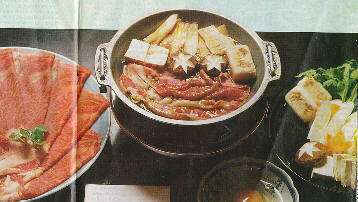
Sukiyaki

Sukiyaki goes back at least to the late Edo Period (1600-1868). At that time, due to the prohibition on eating beef, it was made with wild duck, wild boar or broiled yak.
This changed during the Meiji Period (1868-1912) when the beef prohibition was dropped.
Sukiyaki is made in a heavy iron pan to which warishita (a soy sauce-and sake mixture that has been aged a week) is added, putting in just enough to cover the bottom of the pan. Simmer this then add spring onions, shitake mushrooms, roasted tofu, fu (a baked, gluten bread); shungiku edible chrysanthemum leaves, shiataki (thin noodles) and thin slices of beef. The exact ingredients used, of course, will vary from region to region in Japan.
The ingredients are not allowed to stew; then are taken out and eaten when they are barely cooked. Sometimes they are dipped in a raw-egg sauce and as they eat other vegetables and fresh meat are added to the pan.
Again, once safety factor to consider would be the use of a raw-egg dip which could contain the salmonella bacteria. Leaving that out, though, the dish should be safe to eat.
|